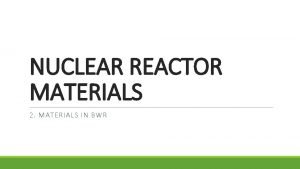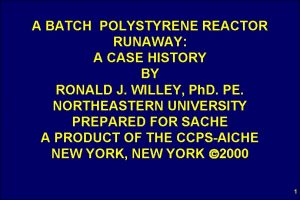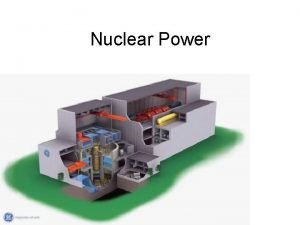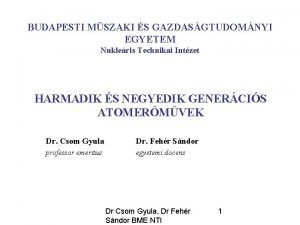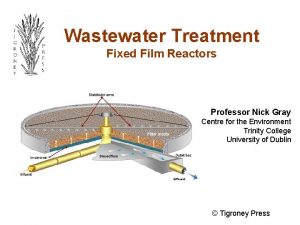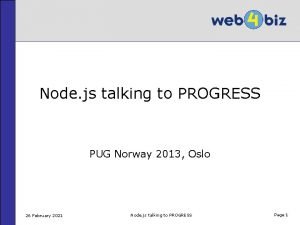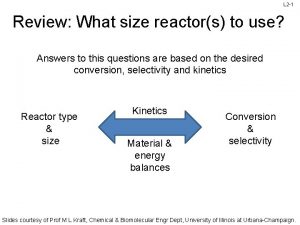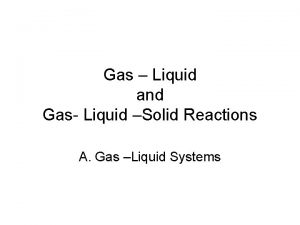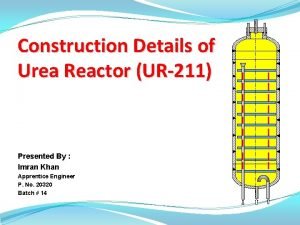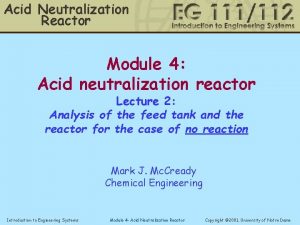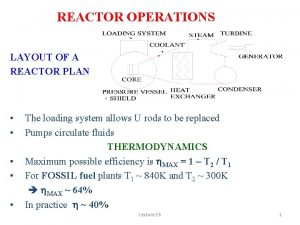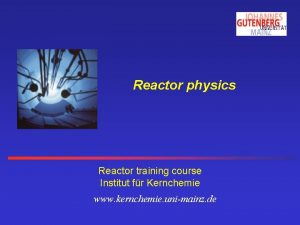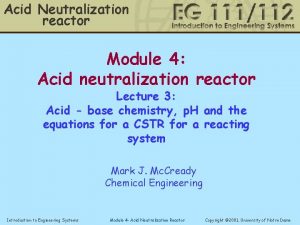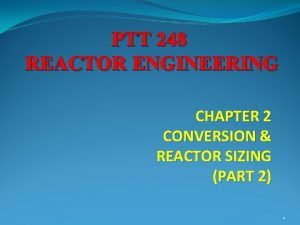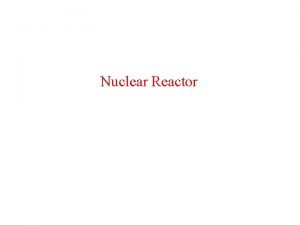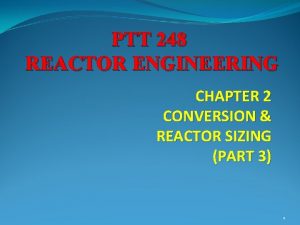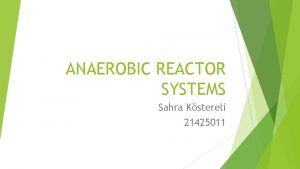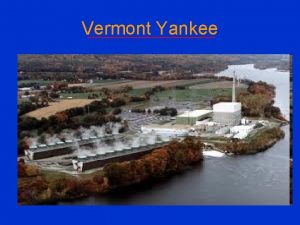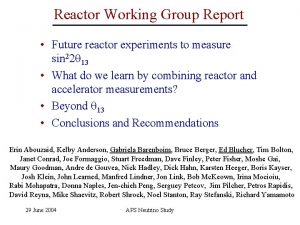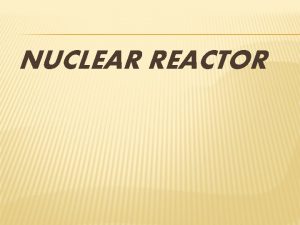Reactor campaign Reactor campaign nr period of the
































































- Slides: 64

Reactor campaign • Reactor campaign ( nr) – • -- period of the reactor power operation from one total refueling to another. 1

• Reactor power operation is accompanied by various effects which cause loss of reactivity or its change. • Therefore, to compensate these effects, the core at the beginning of the operation in cold, not poisoned state should have a certain initial reactivity margin mar due to additional fuel load. • The value mar defines reactor campaign. 2

• Сhange reactivity margin during the reactor campaign Working hours, day

• Reactor campaign is also determined by operating capacity (resistance) of the fuel elements, which largely depends on the accumulation of fission products. • The accumulation of fission products is determined by the permissible burnup fraction and is a characteristic value for a particular type of reactor. • For VVER it is about 3 5%. 4

• Reactor campaign ( nr) - period of the reactor power operation from one total refueling to another. • Fuel campaign ( f) is a fuel residence time in the nuclear reactor core in terms of Wnom during a complete cycle taking into account the n partial refuelings up to obtaining maximum burnup fraction: • f = n nr • Each unloaded portion of fuel is in a nuclear reactor n time intervals nr between refuellings. 5

• Nominal power of a nuclear reactor – • -- is the highest power at which it can operate in all modes provided for the campaign. 6

• Reactor campaign is measured in the effective days (hours) eff. • When reactor power operates at various power levels Wi Wnom during i calendar days (hours), reactor campaign in effective days is recalculated by energy production in the reactor: • Qk = Wi i = Wnom eff, 7

• Energy production of a nuclear reactor – • -- total amount of thermal energy produced during the reporting calendar period of nuclear reactor operation. • Potential opportunities for energy production are characterized by • energy store • and energy source. 8

• Energy content of the nuclear reactor core - energy production from the beginning of its operation until the exhaustion of mar when operating at Wnom. • Energy resource of the nuclear reactor core - energy production from the beginning of its operation at Wnom until the appearance of fatal defects of the core in which its further use is impossible. 9

• Some increase of mar is usually provided for guaranteed supplying of calculation energy resources. • Calendar operation time of nuclear reactor core up to the production of energy resource is called service life. 10

• Fleet average unit capability factor (FAUCF). • Reactor campaign can also be expressed via calendar residence time of fuel in the reactor i and fleet average unit capability factor during this time (load factor). 11

• Fleet average unit capability factor (FAUCF) of a nuclear reactor is the ratio of the average reactor power in the reporting period of time, to the nominal: • FAUCF = Wav / Wnom = (1/ Wnom)( Wi i / i). • • FAUCF is used for quantitative assessment of reactor use intensity. • 12

Energy release in the core. 13

• When the nuclear reactor operates, heating of the core is caused by: • the transfer of kinetic energy of the fission fragments to the surrounding atoms and molecules of the medium, • moderation and neutron radiative capture in all components of the core, • absorption of instant -radiation • and -radiation of the fission fragments and their decay products. 14

• Distribution of energy released in nuclear fission of 235 U by a thermal neutron 15

• The table doesn't consider the contribution of neutrinos accompanying ß-decay of fission fragments, although the energy carried away by them reaches 10 Me. V. • This is because neutrinos do not interact with any substances and, therefore, do not cause heating of the reactor elements. • Very low additional energy from -decay and delayed neutrons were neglected. 16

• Kinetic energy of the fragments and ßparticles is converted into thermal in the immediate vicinity of the fission points. • All antineutrino energy and part of neutron energy and -quanta are carried away by them outside the nuclear reactor core. • This is partly compensated by the energy released in neutron radiative capture ( 7 Me. V). 17

• The relative contribution of different energy carriers, as well as the total fission energy Ef , generated as a result of one fission event, depends essentially • on the properties of used fissile nuclide (235 U, 233 U or 239 Pu), • energy spectrum of neutrons • and absorbing properties of reactor materials. 18

• The spread of values depending on these characteristics, can reach 7%. • That is why, in practical calculations one usually takes that, on average, per one fission event energy is released • Еf = 203 Мэ. В = 0, 32 10 -10 J. 19

• Using these data, by known: • - average density of thermal neutron flux in nuclear fuel Фav, neutron/(cm 2 s) • - volume of fuel V, (cm 3) • - multiplication factor by fast neutrons ( ), • - macroscopic fission cross section 235 U f 5, (cm-1) • we can estimate thermal power, (W), of a nuclear reactor, 20

• thermal power (W), of a nuclear reactor, • is proportional to the amount of nuclear fission in fuel in the reactor core per unit time: • • W = 0, 32 10 -10 Фav V f 5 21

• Reactor power, defined by this expression, is an integral characteristic of the heat release in the nuclear reactor core. • To evaluate heat-stressed cores, one cannot use reactor power , the introduction of special specific characteristics is required. 22

• Important characteristics of the energy -rating of a nuclear reactor are: • specific fuel power, i. e. reactor power per mass unit of uranium in the core, • WGu = W / Gu = 0. 32 10 -10 Фav V f 5 / Gu, • where Gu mass of uranium loaded into the core, (kg); 23

• specific power per mass unit of fissile material in the core, (for VVER 235 U), • WG 5 = = W / G 5 = 0. 32 10 -10 Фav V f 5 / G 5, • where G 5 - mass of 235 U loaded into the core, kg; • • specific volume power (volumetric heat release density), i. e. power per unit of the core • Wv = W / V = 0. 32 10 -10 Фav f 5 24

Unevenness of energy release ( k v, k r , k z ) • A reactor always has unevenness of energy release due to various reasons. • Since thermophysical reactor calculation is carried out for a maximum load, • it is necessary to establish the reasons due to which there is a difference between the average and maximum value of energy release.

• Specific power and energy release in even distribution of all components over the core and constant neutron spectrum are proportional to the neutron flux density which is distributed over the core as follows: • by the height of the cylindrical core without the reflector: • Ф(z) = Ф 0 z cos( z / H);

• by the radius of the cylindrical core: • Ф(r) = Ф 0 r J 0(2. 405 r /R) • Specific volumetric heat release qv, i. e. heat release per unit volume of nuclear fuel for a cylindrical core: • qv(r, z) = qvmax J 0(2. 405 r / R) cos( z / H)

• Assuming that spatial distribution of heat release in the core coincides with distribution of neutron flux density, to move from average to maximum characteristics of heat release rate, one can use uneven distribution coefficients of neutron flux density.

• In the case of nuclear fuel profiling, as in case with VVER reactors, instead of uneven distribution coefficients of neutron flux density, one uses uneven heat release coefficients determining the degree of energy release deviation from the average value in different points of the core. • Uneven heat release coefficients are defined as the ratio of maximum values of specific volumetric heat release, by coordinates, to its average values, by the corresponding coordinates.

• Maximum uneven coefficient by volume determines the allowable power of a nuclear reactor: • kv = krkz = (Ф 0 r / Фav(r)) / (Ф 0 z / Фav (z)) = • = qvmax /qvav = wmax / wav,

• Uneven distribution coefficients of heat release by the radius kr at the selected height of the cylindrical core (z = h): • kr = qvmax(0, h) / qvav(h) = • = qvmax(0, h) / ((1 / R 2) 2 qv(r, h)rdr), • where: qvav(h) average heat release by the radius of the core at height z=h.

• Heat release unevenness coefficients by height kz, at the selected radius of the cylindrical core (r=R 1): • kz = qvmax(R 1, 0) / qvav(R 0) = • = qvmax(R 1, 0) / ((1 / H) qv(R 1, z)dz); • In the core (for example, VVER reactors) there always fuel assemblies of various enrichment and with different burnup.

• To account for energy release unevenness of a certain fuel assembly of the core, • irregularity coefficient of energy release kq • of this FA is introduced, • which is the ratio of its thermal power qi. FA to average power of FA by the core: • kq = qi. FA / qav. FA.

• Distribution of thermal neutron flux by cross section of FA is always uneven. • This unevenness is caused by violation of the uniformity of the lattice, both inside and outside of the fuel assembly. • Unevenness of energy release distribution by the cross section of FA is considered by coefficient k. FA , which is the ratio of maximum energy release in FE to the average FA by FE • k. FA = q. FEmax / q. FEav

• Values of true heat flux may differ from calculated due to manufacturing tolerances for the production of fuel pellets, fuel elements, fuel assemblies, redistribution of coolant rate by FA, inaccuracies of calculated techniques. • These deviations are taken into account by the so-called mechanical unevenness coefficient kmeh.

• One should consider the possibility of power deviation from the nominal value within limits caused by the accuracy of its determination and maintenance. • Furthermore, there may be deviations from the nominal pressure values, coolant inlet temperature and its rate. • These deviations are considered by the socalled unevenness power coefficient • kpower.

• It is also necessary to consider energy release unevenness that arises from the presence of regulating units CPS in the reactor core. • It is taken into account by the unevenness coefficient kabs and greatly depends on the type and position of CPS. • Thus, unevenness coefficient by the reactor volume, which is a ratio of the maximum energy release to the average, equals to: • kv = kr kz kq k. ТВС kmech kpower kabs

• Nuclear reactor power, at a given allowable value of maximum specific power is the greater the closer kv to unity • i. e. the closer energy release at each point of the core to maximum allowable. • Decreasing kv allows to increase nuclear reactor power in the same volume, increase fuel burnup greatly, i. e. to reduce the fuel component of the energy cost.

• The following methods for energy release flattening are used: • 1) use of efficient neutron reflectors located around the core, allowing to reduce neutron leakage and thereby to flatten the distribution of thermal neutron flux density and, thus, heat release. • In thermal reactors, moderator and reflector are usually made of the same material. • The reflective properties of the substance are characterized by reflection factor (albedo), equal to the ratio of the reflected neutron flux to the incident.

• Unevenness coefficients by the radius and height of the cylindrical core with a neutron reflector are approximately equal: • kr = 2. 32(1 + 2 эф / (R + ef))-1; • kz = 1. 57(1 + 2 эф / (H + 2 ef))-1;

• 2) Profiling of the fuel by the core: concentration change (enrichment) of the fissile nuclide by the radius of the core is inversely proportional to the distribution of neutron flux density; • 3) profiling of the solid burnable absorber: its location by the radius and height of the core in direct relation to the distribution of neutron density;

• 4) the choice of regulating units CPS in such quantity and such efficiency so that when operating at certain power their location causes minimum distortion of energy release; • 5) the use of liquid burnable absorber. For VVER, boric acid solution is used.

Residual heat generation • Reduction of heat generation rate in the nuclear reactor after the insertion of a negative reactivity (shutdown of the reactor) is determined by the following processes: • - fission of fuel by prompt neutrons; • - thermal inertia of the core material and the amount of heat accumulated in it; • - fission of fuel by delayed neutrons and photoneutrons; • - slowing-down of and -radiation of fission products accumulated during the operation of a nuclear reactor.

• Change in the power after the nuclear reactor shutdown

• Power caused by fission by prompt neutrons is reduced in a fraction of a second. • Accordingly, Wosk, n, decreases i. e. power caused by slowing-down of fission fragments (Wfrag), deceleration and capture of neutrons (Wn), absorption of instantaneous -radiation (W ). • In fact, heat power is reduced more slowly due to the inertia of heat decline accumulated in the nuclear reactor materials. • Thermal inertia depends on the materials of the core and heat takeoff conditions. • It can be neglected within a few seconds after the power reduction.

• Thermal power caused by fission of delayed neutrons, can be neglected in 3 5 min. • The main component of thermal power in any nuclear reactor, in a few minutes after shutdown there will be heat release W , for a long period of time due to slowing-down , radiation of fission fragments and their decay products, which is, in fact, called residual heat. • To calculate the residual heat power, one uses formulas proposed by different authors.

• The most widespread is Wei and Wigner formula: • W , / W 0 = 6, 5 10 -2[ ст-0. 2 ( ст + Т)-0. 2]; • W , / W 0 = 6, 5 10 -3[ ст-0. 2 ( ст + Т)-0. 2]; • In formula (1) st and Т are given in seconds, • in (2) in days,

• Graph for the approximate evaluation W , after NR shutdown at Т>> st.

• In this fig. , this dependence is represented as a graph, with the help of which we can solve operational problems associated with residual heat without cumbersome calculations. • Graphical dependence enables the operator to perform the following practical tasks: • - define W , at any moment st after reactor shutdown, if it operated per time Т at power W 0; • - evaluate station time st, at the end of which, after reactor shutdown, W , decreases up to the necessary level to move on to the autonomous system of reactor shutdown cooling.

Heat transfer crisis. Conditions of its origin • Boiling heat transfer crisis is called the phenomenon of a sharp deterioration in heat transfer on the heat transfer surface, leading usually to a rapid increase in its temperature. • Thermal load qcr , at which this phenomenon occurs, is called critical.

• Despite the fact that the phenomenon of boiling heat transfer crisis has long been known, the mechanism of this process has not yet been studied in full due to the complexity and diversity of this phenomenon. • Many authors are in favor of the existence of two modifications of heat transfer crisis.

• The first modification of crisis is treated as a consequence of transition of bubble boiling of the liquid to surface. • This phenomenon is called crisis of the first kind. • The researchers said that the crisis of the first kind comes only at high heat fluxes from heat transfer surface, when coolant is not heated to boiling or achieved steam quality is low.

• The most common hypothesis on the mechanism of the crisis of the first kind is that • in the increase in the specific heat load before critical values the rate of generation of steam bubbles is greater than the rate of their removal from the heated surface; • as a result the heating surface is covered with a continuous vapor film.

• Because of the relatively low thermal conductivity of steam, heat transfer coefficient dramatically decreases, which entails overheating of the heat-transfer surface and, as a consequence, the break of FE tightness. • Critical heat flux qcr depends on rate, pressure and temperature of the coolant, shape and dimensions of heat transfer surface.

• This very difficult thermal phenomenon does not have a general analytical solution yet, but for different specific cases, empirical equations are obtained for calculating the qcr in a certain temperature range.

• For example, fo rod cylindrical fuel elements at a pressure 14 20 MPa, subcooling to boiling ts = (10 100) С and coolant rate = 1. 5 7 m/s: • qcr = 35. 400( )0, 5 tн 0, 33( / ( )), • kcal / (m 2 h)

• To prevent film boiling, it is necessary to organize the heat takeoff so that in the most tense fuel elements there is margin by critical heat load: • n = qcr / qmax= qcr/ qcrkv>1,

• The second modification of the crisis, called crisis of the second kind, is interpreted as a result of evaporation or disruption of water microfilm from the FE surface. • It is believed that the crisis of the second kind occurs only with large void fraction exceeding a certain limit mass void fraction, which is determined by pressure and mass flux of coolant.

• The working hypothesis concerning the occurrence of crisis of the second kind connects the development of the crisis phenomenon with the occurrence of pool boiling in the heat generating channel. • With a large void fraction in the liquid flow heated to the saturation temperature, steam bubbles connecting with each other, can fill the whole clear opening of the channel.

• The consequence of this steaming is a decrease in the liquid circulation rate through the channel, thereby creating conditions for evaporation of the water boundary layer on the heat-transfer surface. • The resulting steam film, has low heat transfer properties, the temperature of the heating surface is increased. • A characteristic feature of crisis of the second kind is its independence from the heat load. • The latter determines only jump of the wall temperature.

• The very nature of the crisis phenomenon of the second kind seems to suggest the ways to avoid such modes. • It is increase of subcooling of coolant to boiling, which can be achieved by reducing the coolant temperature or due to pressure increase in the first circuit.

• But coolant temperature decrease is undesirable due to the fact that in this case steam parameters reduce and, consequently, power plant efficiency decreases. • As for the increase of coolant pressure, in the range of operating pressures of the 1 st circuit, it leads to deterioration of conditions of steam bubble disruption from the surface of fuel elements, which facilitates the occurrence of crisis of the first kind.

• Heat transfer modes in the core determine heat engineering reliability of the core - • - it is its ability to keep normal heat removal from the fuel elements within the specified time (fuel campaign) during reactor operation in a stationary mode without exceeding random deviations of structural and operational parameters from their nominal values stipulated in the project.

 The development of children 7th edition
The development of children 7th edition Ce vs ad
Ce vs ad Critical/sensitive periods
Critical/sensitive periods The period of activism was romantic and revolutionary
The period of activism was romantic and revolutionary Absolute refractory period and relative refractory period
Absolute refractory period and relative refractory period Approaches to child development
Approaches to child development Stability period vs measurement period
Stability period vs measurement period Is hyperpolarization the same as refractory period
Is hyperpolarization the same as refractory period The classical period started from 1750 to 1872
The classical period started from 1750 to 1872 Trustee period and royal period
Trustee period and royal period Critical period vs sensitive period
Critical period vs sensitive period Gas atomic mass 16 8 neutrons
Gas atomic mass 16 8 neutrons Kể tên các môn thể thao
Kể tên các môn thể thao Khi nào hổ con có thể sống độc lập
Khi nào hổ con có thể sống độc lập điện thế nghỉ
điện thế nghỉ Thế nào là sự mỏi cơ
Thế nào là sự mỏi cơ Trời xanh đây là của chúng ta thể thơ
Trời xanh đây là của chúng ta thể thơ Voi kéo gỗ như thế nào
Voi kéo gỗ như thế nào So nguyen to
So nguyen to Thiếu nhi thế giới liên hoan
Thiếu nhi thế giới liên hoan Tia chieu sa te
Tia chieu sa te Các châu lục và đại dương trên thế giới
Các châu lục và đại dương trên thế giới Một số thể thơ truyền thống
Một số thể thơ truyền thống Thế nào là hệ số cao nhất
Thế nào là hệ số cao nhất Hệ hô hấp
Hệ hô hấp Tư thế ngồi viết
Tư thế ngồi viết đặc điểm cơ thể của người tối cổ
đặc điểm cơ thể của người tối cổ Hát kết hợp bộ gõ cơ thể
Hát kết hợp bộ gõ cơ thể Mật thư anh em như thể tay chân
Mật thư anh em như thể tay chân Chụp phim tư thế worms-breton
Chụp phim tư thế worms-breton ưu thế lai là gì
ưu thế lai là gì Thẻ vin
Thẻ vin Thể thơ truyền thống
Thể thơ truyền thống Cái miệng xinh xinh thế chỉ nói điều hay thôi
Cái miệng xinh xinh thế chỉ nói điều hay thôi Các châu lục và đại dương trên thế giới
Các châu lục và đại dương trên thế giới Từ ngữ thể hiện lòng nhân hậu
Từ ngữ thể hiện lòng nhân hậu Diễn thế sinh thái là
Diễn thế sinh thái là Tư thế ngồi viết
Tư thế ngồi viết Ng-html
Ng-html V. c c
V. c c Phép trừ bù
Phép trừ bù Chúa sống lại
Chúa sống lại Khi nào hổ con có thể sống độc lập
Khi nào hổ con có thể sống độc lập đại từ thay thế
đại từ thay thế Quá trình desamine hóa có thể tạo ra
Quá trình desamine hóa có thể tạo ra Vẽ hình chiếu vuông góc của vật thể sau
Vẽ hình chiếu vuông góc của vật thể sau Công thức tiính động năng
Công thức tiính động năng Tỉ lệ cơ thể trẻ em
Tỉ lệ cơ thể trẻ em Thế nào là mạng điện lắp đặt kiểu nổi
Thế nào là mạng điện lắp đặt kiểu nổi Dot
Dot Lời thề hippocrates
Lời thề hippocrates Bổ thể
Bổ thể Vẽ hình chiếu đứng bằng cạnh của vật thể
Vẽ hình chiếu đứng bằng cạnh của vật thể Phản ứng thế ankan
Phản ứng thế ankan Reactor pattern
Reactor pattern Boiling water reactor
Boiling water reactor Reactor for eps material
Reactor for eps material Pressurized water reactor
Pressurized water reactor Series reactor compensation
Series reactor compensation Candu reactor construction
Candu reactor construction Submerged fixed-film system
Submerged fixed-film system Reactor pattern
Reactor pattern Vertical
Vertical Solid
Solid Urea reactor design
Urea reactor design























































